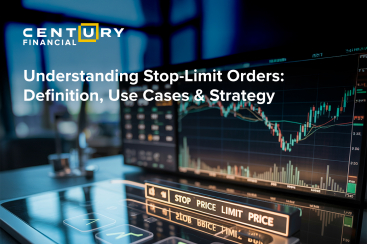Monday, August 29, 2022
A Beginner's Guide to Price Action Trading Strategies
By Century Financial in 'Blog'


Day trading involves buying and selling securities within a single trading day, instead of holding onto them for many years. Day traders use different strategies to decide which assets to buy or sell. Price Action Trading is one such method that traders use to make decisions about buying and selling stocks.
What is Price Action Trading?
Price Action Trading is a trading technique that involves analyzing the recent price movements of a financial asset to speculate on the future direction of that asset. This trading strategy takes an intuitive, gut-based approach as compared to technical analysis. While it will involve referencing technical analysis tools, it doesn’t solely rely on them. Instead, price action traders spot patterns in the price movement of an asset that signal the start of a trend.
Price action trading strategies combine a trader’s knowledge, recent research, technical analysis tools and study of actual price movements within a trading day to make subjective trading decisions. A technical analyst might need more data points to make a trading decision whereas a price action trader looking at the same technical charts can notice the emergence of a trend and make decisions faster.
A trader following a price action strategy concentrates on the movement of prices when they are planning to trade in that stock. For example, if there’s an increase in the price of a stock, then the trader assumes that many people are buying it and evaluates the aggressiveness with which the investors are buying the stock. The trader then makes their decisions to trade in that stock after understanding the bids, trading volume, velocity, and other aspects.
Price Action Trading Strategies
Price Action Traders use tools like candlesticks and breakouts to create trading strategies. Candlesticks are graphical representations on a chart showing the price of an asset at various stages like the trend, open, close, high, and low price of an asset. A breakout indicates that a stock price has moved outside its specific tendency, alerting traders that the price might continue to move in that direction. Apart from these graphs, other tools involved in price action strategies are trends that describe fluctuations in price movements and support and resistance, which are used to identify good trading opportunities.
There are many price action trading strategies that you can choose from. A few of the popular trading strategies are:
Pin Bar or Candlestick Strategy
A pin bar pattern resembles a candle with a long wick. This pattern represents a sharp reversal of a particular price. The candle wick in this pattern indicates the price range that was rejected by investors. Looking at this pattern, the trader assumes that the price will start moving in the opposite direction to the tail and then decides whether to take a long or short position.
Inside bar
An “inside bar” pattern is a two-bar price action trading strategy in which the inside bar is smaller and within the high to low range of the prior bar The inside bar pattern describes two bars - one within the other. The inner bar falls within the high and low range of the previous (outer or mother bar). Such inside bars are formed during moments of market consolidation. This market condition occurs when the stock prices trade within a narrow price range, neither reversing nor continuing a larger price trend.
Experienced traders can immediately spot this trend and use their knowledge to predict whether the inside bar represents market consolidation or a turning point.
Head and Shoulders Reversal
The head and shoulders chart pattern is a well-known and simple-to-spot pattern that displays a baseline with three peaks, the middle peak being the highest. The head and shoulders chart shows a bullish-to-bearish trend reversal and alerts traders that an uptrend is about to come to an end. A head and shoulder pattern occurs when the stock market prices rise, then fall, rise even further than before, fall again, and rise to a lower high before dropping to a modest level. This pattern looks like the head and shoulders of a person. Head and shoulders reversal trade is one of the most popular price action trading strategies as it is simple to choose an entry point and set a stop loss
A trade can be initiated when the pattern completes. The most frequent entry point is when a breakout has taken place—the neckline is broken, and a trade is entered. After the neckline is penetrated in the typical market top pattern, the stops are positioned slightly above the right shoulder (topping pattern).
Summing up
Price Action Trading is a trading method that involves the analysis of price movements to predict future market movements. In price action trading, traders focus on trends and patterns and do not completely depend on technical indicators to make trading decisions. Some of the most popular price action trading strategies are Inside Bar, Head and Shoulders Reversal, and Pin Bar trading strategies.
For any beginner trader, learning to read and interpret price chart movements is an essential skill. It can be applied with other analysis tools like statistics, indicators, or seasonality. If you’re learning to trade, you can practice by creating a demo account on trading software. Through this platform, you can engage in a risk-free environment to practice trading stock indices, currencies, and commodities in the Dubai Market Trading and other global markets.
The content in this blog, including any research, analysis, opinions, forecasts, or other information (collectively, "Information"), is provided by Century Financial Consultancy LLC (CFC) for marketing, educational, and general informational purposes only. It should not be construed as investment advice, a recommendation, or a solicitation to buy or sell any financial instruments.
This Information may also be published across various channels, including CFC’s website, third-party platforms, newsletters, marketing materials, emails, social media, messaging apps, webinars, and other communications. While CFC strives for accuracy, we do not guarantee the completeness, reliability, or timeliness of any content. Any decisions made based on this Information are at your own risk. CFC accepts no liability for any loss or damage arising from its use.
Trading financial products involves significant risk and may not be suitable for all investors. Please ensure you fully understand the risks and seek independent professional advice if necessary.
Please refer to the full risk disclosure mentioned on our website.









.png)
.png)
.png)
.png)


